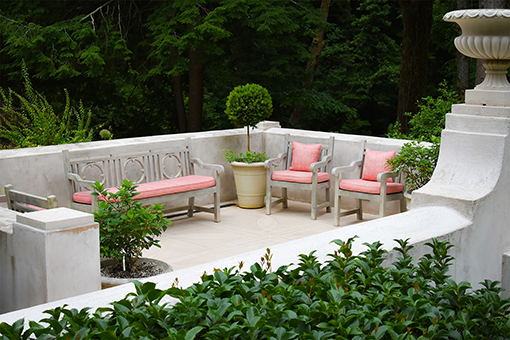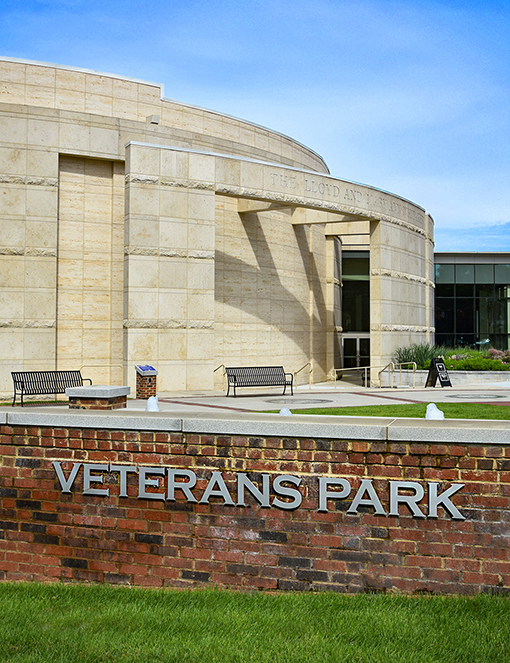If you've lived in Atlanta for a month or a lifetime, or even if you've visited Atlanta for a long weekend, you've been touched by the work and the incredibly generous philanthropy of the Goizueta family.
Olguita Casteleiro de Goizueta held many leadership roles through volunteer work with the
Atlanta History Center, the Latin American Association, the Atlanta Symphony Orchestra, the High Museum of Art, and many others. Her husband,
Roberto C. Goizueta, is well-known as the former Chairman and CEO of
The Coca-Cola Company who grew the company from $4.3 billion in 1981 to a high of $145 billion (some sources cite $180 billion) in 1997, the year of his death. That transformation of The Coca-Cola Company created a large number of millionaires in Metro Atlanta.
 |
Olguita's Garden | Atlanta History Center | Photo: Travis Swann Taylor
|
The Goizueta Foundation was formed only a few short years before Roberto's death in 1997, aged 65. Shortly after his death, Olguita became trustee and chairman of the Foundation and ran it most of the years of the rest of her life.
Since its founding in the early 1990s, the Goizueta Foundation has provided support for more than 297 organizations through 638 grants, totaling more than $601,000,000!
On the occasion of Olguita's 80th birthday, her children gifted her a life-size portrait of her and her husband, by Atlanta artist Ross Rossin, displayed at the offices of The Goizueta Foundation. Perhaps the only more famous image of the two is one of them when they were teenagers on a date, both holding bottles of Coca-Cola.
 |
Olguita's Garden | Atlanta History Center | Photo: Travis Swann Taylor
|
Olguita, with her three children, stepped off a boat in Miami, having fled Fidel Casto-ruled Cuba. Roberto joined them soon after. They arrived in the U.S. with $40 and 100 shares in Coca-Cola stock (Roberto had worked for Coca-Cola when in Cuba).
 |
Olguita's Garden | Atlanta History Center | Photo: Travis Swann Taylor
|
She was a former member of the Board of Trustees of Emory University, where the business school is named for her husband, Emory University's Goizueta Business School.
Olguita Casteleiro de Goizueta passed on November 16, 2015, aged 81. Olbuita's life was celebrated in a special service at the Monastery of the Holy Ghost with family, Foundation staff, her caregivers, and closest friends.
Following Olguita's passing, the Board of Directors of the Goizueta Foundation includes the Goizueta's three living children, Olga Goizueta Rawls (chair and CEO), Javier Goizueta, and Roberto Goizueta.
 |
Olguita's Garden | Atlanta History Center | Photo: Travis Swann Taylor
|
The Goizueta Foundation has been generous to the Atlanta History Center since the early 1990s. Their initial grant to the Atlanta History Center was "to support educational programs" was for $75,000.
The Foundation's granting process focuses primarily on institutions of education and educational programs. They do not fund religious or political persons or entities. Their reach is a 10-county region in Metro Atlanta.
 |
Olguita's Garden | Atlanta History Center | Photo: Travis Swann Taylor
|
To help visitors understand why you see the name Goizueta around the 33-acre campus of the Atlanta History Center, here are some of the contributions made to the Center by the Goizueta Foundation over the years:
1993-1996 - $75,000 to support education programs.
1998 - $100,000 to support the Folk Life Festival.
2001 - $358,750 to develop and support the Distance Learning program for three years, and to expand and support the Outreach Program for three years.
2010 - $829,750 to implement a new education initiative to modernize the current curriculum as well as execute a new marketing program.
2013 - $3,000,000 to support the 33-acre Historic Gardens and Trails to engage new audiences through expansive historic outdoor spaces.
2016 - $4,500,000 to establish and endow the Olga C. de Goizueta Memorial Garden, and to establish The Goizueta Foundation Endowed Fund for the Olga C. de Goizueta Gardens.
2017 - $4,000,000 to support Goizueta Gardens’ Living Collections management; to support rebranding of Goizueta Gardens' signage and marketing efforts over four years; and to establish The Goizueta Foundation Endowed Fund for Goizueta Gardens.
I am one of millions of Atlantans who are grateful to the Goizueta family for their thoughtful generosity and to the Atlanta History Center for being such mindful stewards of those kind gifts.
 |
Olguita's Garden | Atlanta History Center | Photo: Travis Swann Taylor
|
Planted along the outside wall of this garden, look for the special camellia—the "Olguita" camellia—introduced by the Atlanta History Center in 2018 in honor of Olguita C. de Goizueta.
 |
Olguita's Garden | Atlanta History Center | Photo: Travis Swann Taylor
|
While "Goizueta Gardens" encompasses all of the gardens throughout the Atlanta History Center's 33 acres, "Olguita's Garden" is relatively new and it's absolutely stunning! Located just outside the back of the Museum Building, on the way to Swan House or Smith Family Farm, it's a beautifully landscaped ornamental garden with numerous flowers—particularly magnificent in the spring, but planted for year-round interest—espalier Keiffer pear trees, and comfortable antique French outdoor furniture for lounging.
The focal point of the garden is a water feature surrounded by limestone columns designed by renowned Atlanta architect Neel Reid.
 |
Olguita's Garden | Atlanta History Center | Photo: Travis Swann Taylor
|
This is the perfect spot for a small wedding or other social occasion! Ask any of the staff about hosting a special event here or visit the Private Events page on their website.
 |
Olguita's Garden | Atlanta History Center | Photo: Travis Swann Taylor
|
Olguita and Roberto had a fourth child in 1966 after coming to the United States, a son named Carlos, but tragically he passed of leukemia at a very early age, in 1970.
Olguita was a faithful member of Holy Spirit Catholic Church in Atlanta and frequently visited the Monastery of the Holy Spirit in Conyers, Georgia, where a statue of the Virgin Mary and Baby Jesus are centered in the Memorial Plaza and Prayer Walk, gifted by Olguita Goizueta. There are plaques honoring the memory of her late son Carlos, as well as plaques for her and her late husband Roberto.
 |
Olguita's Garden | Atlanta History Center | Photo: Travis Swann Taylor
|
When you next visit the Atlanta History Center's nine gardens, collectively named "Goizueta Gardens", be sure to stop by Olguita's Garden and explore and/or relax for a few minutes. Enjoy this lovely respite from busy city life. It's waiting just for you!
The Other Gardens: This is the seventh post in a series sharing the beauty of the nine gardens on the Atlanta History Center's 33-acre campus. You can find them all here.







































